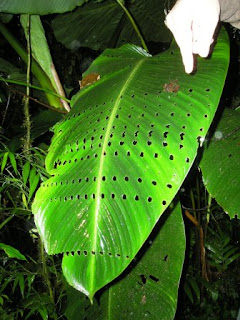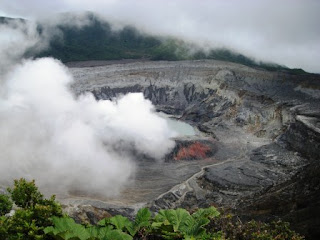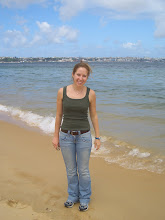Upon leaving Monteverde, we set off on a seven-hour bus ride for Nicaragua. We arrived, ate lunch, cleared Costa Rican customs, and loaded our backpacks and ourselves into a strange bus-like boat on the San Juan River. From there we traveled three hours downriver to the west, stopping at one point to clear Nicaraguan customs. We arrived at our station at Refugia Bartola around 7:30, unloaded the boat, and moved into our three-person rooms. Refugia Bartola was an interesting combination between a tourist lodge and a biological station. While the rooms were rustic and bare (bunk beds with mosquito nets), the dining and common area was a beautiful paved area with hammocks, a long rectangular table with a white tablecloth, and a high thatch roof. Unlike at the other stations, the meals at Refugia Bartola were served to us, complete with different courses! Temporarily, we felt like we were living in luxury.
^The boat that took us down the San Juan River to Refugia Bartola.
 ^View from the boatride.
^View from the boatride.
 ^The dining and common area at Refugia Bartola.
^The dining and common area at Refugia Bartola.
We spent the day after our arrival doing the usual new-station business - learning about the area and going on orientation walks. We also began preparing for the two faculty-led projects that were supposed to take place that week, which involved catching fish in the river and wandering through the woods looking for bat tents under big leaves. After dinner, we caught bats and nets and examined them in the thatch-roof common area, which was really neat. The professor that was handling the bats got bitten at one point, and we've been teasing him ever since that he now has rabies. We went to bed that night tired and happy, but were rudely awakened in the middle of the night... I'm going to just paste the story of what happened that I e-mailed to a few of my friends. ^Cool tree in the forest near the lodge.
^Cool tree in the forest near the lodge.
 ^One of the bats we netted and examined.
^One of the bats we netted and examined.First, a quick description of the place where we were staying - the main part of the building was a wide, really tall circular open area with a thatch roof that served as the dining room, common area, etc. To this was attached the kitchen, and to the kitchen a row of eight small bunk rooms with 3-4 beds in each room - I was staying in room 7.

On Tuesday night my two roommates and I went to bed at 11:11 (I know this because it was 11/11 so we decided to stay up and make a wish). We woke up sometime after midnight to our professor yelling from outside and other loud noises - a fire had started in the kitchen and the huge thatch roof was completely consumed in flames that were probably three or four stories high. I ran out my door, looked to my right, and was (seriously) temporarily frozen with fear. I remember wondering how in the world the fire had gotten so huge before anyone woke up - it was terrifying. After a second I realized that some other students were standing outside their rooms looked dazed, so (in true form) I started yelling my head off... something like, "WAKE UP EVERYONE IN YOUR ROOM! GET YOUR PASSPORT, GET A LIGHT, PUT YOUR SHOES ON, AND GET OUUUUTTTT!" My classmates later joked that for once, my painfully loud voice had come in handy. We quickly made our way out of the building for fear that the gasoline in the kitchen would explode, but it turned out that had already happened while we were still sleeping. With the help of the guys at the station, we managed to get everyone's stuff out of their rooms, because the wind was blowing away from the bunk rooms and the fire was actually moving slowly. Amazingly, the guys at the station managed to put the fire out by tearing out the roof above the first bunk room and spraying it with a hose - in the end, the fire only reached the first bunk room. The only thing I lost was my watch, and my only injury was an absolutely huge and disgusting bruise on my leg- I probably ran into something in the initial panic, but I strangely have no recollection of doing so. We left Nicaragua the next morning the same way we had come and stayed in San Jose until the following Saturday, when we traveled to Palo Verde in the northwest of Costa Rica. Thinking back to the whole thing seems pretty surreal -none of us like to think of how bad things could have been if our professor hadn't heard the fire and woken up (there were, of course, no fire alarms). We were also extremely lucky that the wind was blowing away from our rooms - we were completely in the middle of nowhere and would have been in major trouble had the fire made its way into the adjoining forest.

^Nobody really got much in the way of pictures of the fire, but here's one Becca took- the flames you can see are rising high above the bunk rooms, which are between the camera and the fire.

^The dining area the morning after the fire.

^Sorting through all of our stuff the morning after the fire was a bit of a nightmare as everything had been thrown in a giant pile in the rush to get it out of the building, but obviously we were just grateful not to have lost all of it.
Thankfully, our professors gave us a lot of free time during our couple of days in San Jose, so we were all able to calm down and chill out a little bit. We're now staying at an OTS station in Palo Verde, but more on that to come later. ^Claire and I dying Tim's hair blue on one of our free nights in San Jose... good times.
^Claire and I dying Tim's hair blue on one of our free nights in San Jose... good times.










 ^My, Courtney's, Claire's, and Becca's room at Palo Verde. My bunk, into which the rat climbed on our second-to-last night, is on the bottom right.
^My, Courtney's, Claire's, and Becca's room at Palo Verde. My bunk, into which the rat climbed on our second-to-last night, is on the bottom right.






















 ^Hanging out on the porch outside our rooms at night :)
^Hanging out on the porch outside our rooms at night :)

 ^Botfly larva coming out of Jess's head... ewww.
^Botfly larva coming out of Jess's head... ewww.
















